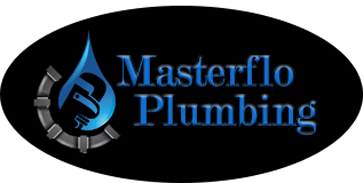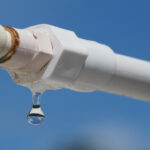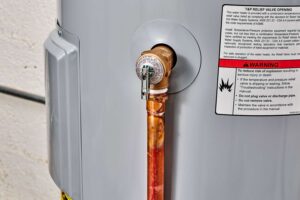To fix pipe leaks on your own, you can try using pipe clamps or epoxy putty for minor issues. Consider temporary solutions like pipe wraps or rubber tape. Look into pipe repair kits from hardware stores or sealing leaks with plumbing solder. These methods are efficient and cost-effective for handling plumbing problems. Remember, there are more techniques available to explore further in resolving pipe leak repairs.
Key Takeaways
- Fix minor leaks with pipe clamps or epoxy putty.
- Use pipe wraps for temporary solutions.
- Apply rubber or silicone tape for quick fixes.
- Utilize pipe repair kits from hardware stores.
- Seal leaks with plumbing solder or adhesive compounds.
Identifying the Leak
To begin identifying the leak, start by inspecting all visible pipes for signs of water seepage or dripping. Look for any wet spots, discoloration, or mold growth near the pipes. Use a flashlight to check dark corners or areas with limited visibility. Pay close attention to joints and connections where leaks commonly occur. If you notice any water droplets or a damp feeling when you run your hand along the pipes, mark those spots for closer inspection.
Next, observe your water meter. Make sure no water is being used in your home, then check if the meter is still running. A moving meter when no water is being consumed indicates a leak in the plumbing system. This method can help you pinpoint the general area of the leak.
Gathering Necessary Tools
Consider preparing a toolbox with the essential tools needed for the DIY pipe leak repair. To effectively address the leak, you will require a few key items. First and foremost, have an adjustable wrench on hand to tighten or loosen pipe connections. A pipe cutter will be necessary if the damaged section needs to be replaced. Additionally, make sure to have plumber's tape or thread sealant to seal any joints securely. A pipe repair clamp can provide a temporary fix for larger leaks. Don't forget a bucket or a container to catch any excess water that may leak during the repair process. A flashlight can be handy for illuminating dark areas where the leak might be located. Finally, keep some rags or towels nearby to clean up any spills or drips. By gathering these tools beforehand, you can efficiently tackle the pipe leak repair task.
Temporary Patch Solutions
Prepare for a quick fix by exploring temporary patch solutions for addressing pipe leaks. When dealing with a sudden pipe leak, these quick fixes can help you manage the situation until a more permanent solution can be implemented. Here are some temporary patch solutions worth exploring:
- Rubber and Hose Clamps: Use a rubber sheet and hose clamps to create a tight seal around the leaky area.
- Pipe Repair Tape: Wrap self-fusing silicone tape around the leaking pipe to stop or reduce the flow of water.
- Epoxy Putty: Moldable epoxy putty can be used to fill and seal small leaks in pipes temporarily.
- Plumbing Epoxy Stick: This stick can be applied directly to the leaky area and sets underwater, providing a temporary seal until further repairs can be made.
These temporary patch solutions are handy for quickly addressing pipe leaks and buying you some time before a more permanent fix is implemented. Remember, these are interim solutions, and it's crucial to follow up with proper repairs to prevent future leaks.
Epoxy Putty Application
To apply epoxy putty to seal small leaks in pipes temporarily, follow these simple steps. First, make sure the pipe surface is clean and dry. Then, cut a piece of epoxy putty from the stick and knead it until the color is uniform. Apply the putty directly onto the leaking area, pressing it firmly to cover the leak completely. Smooth out the putty to ensure a tight seal. Let it cure for the recommended time as per the product instructions. Once cured, turn on the water to check if the leak is sealed. Epoxy putty is a quick and effective solution for small pipe leaks, providing a temporary fix until a permanent solution can be implemented. Remember, epoxy putty is not suitable for high-pressure leaks or long-term repairs. If the leak persists or worsens, consider consulting a professional plumber for a more permanent fix.
Pipe Clamp Installation
To guarantee a temporary fix for a leaking pipe, consider installing a pipe clamp as a quick and efficient solution. Pipe clamps are readily available at hardware stores and can be easily installed with basic tools. Here's a simple guide to help you tackle this DIY repair:
- Assess the Leak: Before purchasing a pipe clamp, evaluate the size and location of the leak on the pipe. Make sure that the clamp you choose is appropriate for the type of pipe and the size of the leak.
- Prepare the Pipe: Clean the area around the leak to make sure that the pipe clamp adheres properly. Dry the pipe thoroughly before installation.
- Install the Pipe Clamp: Position the rubber gasket of the pipe clamp over the leak and secure the clamp in place using a screwdriver. Tighten the screws evenly to create a proper seal.
- Test the Repair: Turn on the water supply to check if the leak has been successfully sealed. Monitor the pipe clamp for any signs of leakage and make adjustments if necessary.
Compression Coupling Fix
When addressing a compression coupling fix for a leaking pipe, make sure you have the necessary tools and materials ready for a successful repair. Begin by turning off the water supply to the affected area. Next, clean and dry the pipe where the leak is located to guarantee a proper seal. Slide one compression sleeve onto each end of the leaking pipe, followed by the rubber gaskets. Insert the compression coupling onto the pipe ends, making sure it fits snugly. Then, tighten the nuts on the coupling with a wrench until the leak stops. Check for any remaining leaks and turn the water supply back on if the repair is successful. Compression coupling fixes are relatively straightforward and can be an effective solution for minor pipe leaks. Remember to follow manufacturer instructions for your specific coupling to ensure a proper repair.
Repairing With Pipe Sleeves
Consider utilizing pipe sleeves as a practical solution for repairing minor pipe leaks. Pipe sleeves are easy to install and can provide a temporary fix until a more permanent solution is implemented. Here are some steps to guide you through the process:
- Prepare the Pipe: Clean the area around the leak and make sure that the pipe is dry before proceeding.
- Select the Correct Sleeve: Choose a pipe sleeve that is the appropriate size and material for your pipe.
- Cut the Sleeve: Use a pipe cutter to trim the sleeve to the required length, making sure it covers the leaky area adequately.
- Install the Sleeve: Slide the sleeve over the leaking section of the pipe and secure it in place using clamps or compression fittings.
Soldering Technique
To guarantee pipe leaks are fixed effectively, mastering the soldering technique is essential. Soldering creates a strong, watertight seal that can withstand high water pressure, making it a reliable method for repairing pipe leaks. To begin, make sure the leaking pipe is clean and dry before starting. Next, use an emery cloth to sand the area around the leak to remove any corrosion or debris. Apply flux to the cleaned area to help the solder adhere to the pipe. Heat the joint evenly using a propane torch until the flux starts to bubble. Once the pipe reaches the correct temperature, touch the solder to the joint, allowing it to melt and flow into the gap, creating a secure bond. After soldering, let the pipe cool naturally before turning the water back on to check for leaks. Remember to always follow safety precautions when working with a torch to avoid accidents. Mastering the soldering technique will empower you to tackle pipe leaks confidently and effectively.
Seeking Professional Help
If you encounter complex or extensive pipe leaks, consulting a professional plumber is highly recommended. While many minor leaks can be fixed with DIY methods, certain situations call for the expertise of a professional. Here are some reasons why seeking professional help is vital:
- Expertise: Plumbers have the knowledge and experience to accurately assess the extent of the leak and determine the best course of action.
- Specialized Equipment: Professionals have access to specialized tools and equipment that may be necessary for repairing certain types of pipe leaks effectively.
- Ensures Safety: Complex leaks can pose safety hazards, and professional plumbers are trained to handle such situations safely.
- Long-Term Solutions: Professionals can provide long-lasting solutions that prevent future leaks, saving you time and money in the long run.
Conclusion
Masterflo Plumbing is North Georgia's premier plumbing company, boasting over 20 years of experience and a team of skilled master plumbers. We are equipped and prepared to handle all your plumbing needs, whether it's water heater repairs, replacements, or addressing minor and major plumbing issues. Serving Cherokee County and metro Atlanta, you can rely on Masterflo Plumbing for top-notch plumbing services.



No comment yet, add your voice below!